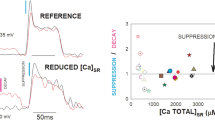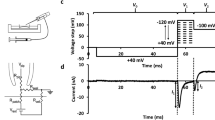Abstract
The behavior of single chloride channels in sarcoplasmic reticulum of rabbit and trout skeletal muscle was examined by fusing isolated vesicle fractions into planar lipid bilayers. The channel exhibited a full open state with a unit conductance of 65 pS (in 100 mM Cl-) and several subconductance states with reversal potentials which were dependent on the chloride gradient across the bilayer. Open probability was 0.6–0.95 for membrane potentials ranging from-60 to+60 mV. The kinetic behaviour could be described by assuming one time constant for the fully conducting channel, and at least two time constants for the non-conducting channel. In the presence of methane sulfonate, sulfate and phosphate anions, a decrease in the unit current amplitude but not open time argued in favor of a competition between these anions and Cl- at the transport site of the channel. Chloride channel activity was not affected by variations of Ca2+ concentration in both chambers or by the presence of Mg2+. Similarly, neither millimolar ATP nor the presence of the drugs taurine (up to 10 mM), lidocaine (2–40 μM) or the calmodulin antagonist W7 (5–150 μM), modified channel behavior. Finally, pH variations between 6.8 to 8 were without effect.
Similar content being viewed by others
Abbreviations
- DIDS :
-
4,4′-Diisothiocyanostilbene-2,2′-disulfonic acid
- EGTA :
-
Ethylene glycol bis-(β-aminoethyl ether) N,N,N',N'-tetraacetic acid
- HEPES :
-
N-2-Hydroxyethyl-piperazine-N'-2-ethane sulfonic acid
- SR :
-
Sarcoplasmic reticulum
- TRIS :
-
Tris(hydroxymethyl)aminomethane
References
Barrett JN, Magleby KL, Pallotta BS (1982). Properties of single calcium-activated potassium channels in cultured rat muscle. J Physiol (London) 331:211–230
Bezanilla F (1985) A high capacity data recording device based on a digital audio procesror and a video cassette recorder. Biophys J 47:437–441
Blatz AL, Magleby KL (1985) Single chloride-selective channels activate at resting membrane potentials in cultured rar skeletal muscle. Biophys J 47:119–123
Blatz AL, Magleby KL (1986) Quantitative description of three modes of activity of fast chloride channels from rat skeletal muscle. J Physiol (London) 378:141–174
Bormann J, Hamill OP, Sakmann B (1987) Mechanism of anion permeation through channels gated by glycine and γ-aminobutyric acid in mouse cultured spinal neurones. J Physiol (London) 385:243–286
Colombini M (1979) A candidate for the permeability pathway of the outer mitochondrial membrane. Nature 279:643–645
Coronado R, Latorre R (1982) Detection of K+ and Cl- channels from calf cardiac sarcolemma in planar lipid bilayer membranes. Nature 298:849–851
Coronado R, Miller C (1982) Conduction and block by organic cations in a K+ selective channel from sarcoplasmic reticulum. J Gen Physiol 79:529–547
Coulombe A, Duclohier H (1984) A large unit conductance channel permeable to chloride ions in cultured rat heart cells. J Physiol (London) 250:P59
Franciolini F, Petris A (1988) Single chloride channels in cultured rat neurones. Arch Biochem Biophys 261:97–102
Garcia AM, Miller C (1984) Channel mediated monovalent cation fluxes in isolated sarcoplasmic reticulum vesicles. J Gen Physiol 83:819–839
Gray PTA, Bevan S, Ritchie JM (1984) High conductance anion selective channels in rat cultured Schwann cells. Proc. R Soc (London) B221:395–409
Hamill OP, Bormann J, Sakmann B (1983) Activation of multiple conductance state chloride channels in spinal neurons by glycine and GABA. Nature 305:805–809
Hanraham JW, Alles WP, Lewis SA (1985) Single anion-selective channels in basolateral membrane of a mammalian tight epithelium. Proc Natl Acad Sci USA 82:7791–7795
Huxtable R, Bressler R (1973) Effect of taurine on a muscle intracellular membrane. Biochim Biophys Acta 323:573–580
Inui M, Saito A, Fleisher S (1987) Purification of the ryanodine receptor and identity with feet structures of functional terminal cisternae of sarcoplasmic reticulum from fast skeletal muscle. J Biol Chem 262:1740–1747
Kasai M, Kometani T (1979) Inhibition of anion permeability of sarcoplasmic reticulum vesicles by 4-acetoamido-4-isothiocyanostilbene-2,2-disulfonate. Biochim Biophys Acta 557: 243–247
Kasai M, Kanemasa T, Fukumoto S (1979) Determination of reflection coefficients for various ions and neutral molecules in sarcoplasmic reticulum vesicles through osmotic volume change studies by stopped flow technique. J Membr Biol 51: 311–324
Kometani T, Kasai M (1978) Ionic permeability of sarcoplasmic reticulum vesicles measured by light scattering method. J Membr Biol 41:295–308
Lai FA, Erickson H, Rousseau E, Liu QY, Meissner G (1988) Purification and reconstitution of the calcium release channel from skeletal muscle. Nature 331:315–319
Magleby KL, Pallotta BS (1983) Calcium dependence of open and shut interval distribution from calcium activated potassium channels in cultured rat muscle. J Physiol (London) 344:585–604
Meissner G (1983) Monovalent ion and calcium ion fluxes in sarcoplasmic reticulum. Mol Cell Biochem 55:65–82
Meissner G (1984) Adenine nucleotide stimulation of Ca2+ induced Ca2+ release in sarcoplasmic reticulum. J Biol Chem 259:2365–2374
Meissner G, McKinley D (1976) Permeability of sarcoplasmic reticulum membrane. The effect of changed ionic environment on Ca2+ release. J Memb Biol 30:79–98
Miller C (1978) Voltage gated cation conductance channel from fragmented sarcoplasmic reticulum: steady state electrical properties. J Membr Biol 40:1–23
Miller C, White MW (1984) Dimeric structure of single chloride channels from torpedo electroplax. Proc Natl Acad Sci USA 81:2772–2775
Montal M, Larbaca P, Fredkin DR, Suarez-Isla BA (1984) Channel properties of the purified acetylcholine receptor Torpedo California reconstituted in planar lipid bilayer membranes. Biophys J 45:165–179
Nelson DJ, Tang JM, Palmer LG (1984) Single channel recordings of apical membrane chloride conductance in A6 epithelial cells. J Membr Biol 80:81–89
Rousseau E, Smith JS, Henderson JS, Meissner G (1986) Single channel and 45Ca2+ flux measurements of the cardiac sarcoplasmic reticulum calcium channel. Biophys J 50:1009–1014
Rousseau E, Smith JS, Meissner G (1987) Ryanodine modifies conductance and gating behavior of Ca2+ release channel. Am J Physiol [Cell Physiol] 253:C364-C368
Sachs F, Neil J, Bakakati N (1982) The automated analysis of data from single ionic channels. Pflügers Arch 395:331–340
Schwarze W, Kolb HA (1984) Volgtage-dependent kinetics of an anionic channel of large unit conductance in macrophage and myotube membranes. Pflügers Arch 402:281–291
Smith JS, Coronado R, Meissner G (1985) Sarcoplasmic reticulum contains adenine nucleotide activated calcium channels. Nature 316:446–449
Smith JS, Coronado R, Meissner G (1986a) Single channel measurements of the calcium release channel from skeletal muscle sarcoplasmic reticulum. Activation by Ca2+ and ATP and modulation by Mg2+. J Gen Physiol 88:573–588
Smith JS, Coronado R, Meissner G (1986b) Single-channel calcium and barium currents of large and small conductance from sarcoplasmic reticulum. Biophys J 50:921–928
Smith JS, Coronado R, Meissner G (1988) Techniques for observing calcium channels from skeletal muscle sarcoplasmic reticulum in planaar lipid bilayer. Methods Enzymol 157: 480–489
Suarez-Isla BA, Orozco C, Heller PF, Froehlich JP (1986) Single calcium channel in native sarcoplasmic reticulum membranes from skeletal muscle. Proc Natl Acad Sci USA 83: 7741–7745
Tank DW, Miller C, Webb WE (1982) Isolated-patch recording from liposomes containing functionally reconstituted chloride channels from Torpedo electroplax. Proc Natl Acad Sci USA 79:7749–7753
Welsh MJ (1986) An apical-membrane chloride channel in human tracheal epithelium. Science 232:1648–1650
Yamamoto N, Kasai M (1981) Kinetic analysis of the inhibition of anion transport in sarcoplasmic reticulum vesicles by a disulfonic stilbene derivative. Measurement of the change in chloride-diffusion potential by using a fluorescent cyanine dye. J Biochem 89:1521–1531
Author information
Authors and Affiliations
Rights and permissions
About this article
Cite this article
Rousseau, E., Roberson, M. & Meissner, G. Properties of single chloride selective channel from sarcoplasmic reticulum. Eur Biophys J 16, 143–151 (1988). https://doi.org/10.1007/BF00261900
Received:
Accepted:
Issue Date:
DOI: https://doi.org/10.1007/BF00261900




